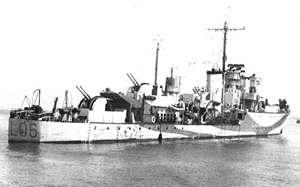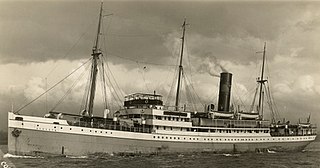
HMS Malcolm was one of eight Admiralty-type destroyer leaders built for the Royal Navy during World War I. She was the first of only two Royal Navy ships to carry the name Malcolm, although HMS Valkyrie was originally planned to bear the name. She was one of two Admiralty-type leaders to miss the First World War but saw service in, and survived, the Second World War. Her pennant number was changed from D19 to I19 in May 1940. She was broken up in 1945.

HMS Forester was one of nine F-class destroyers built for the Royal Navy during the early 1930s. Although assigned to the Home Fleet upon completion, the ship was attached to the Mediterranean Fleet in 1935–36 during the Abyssinia Crisis. A few weeks after the start of World War II in September 1939, she helped to sink one German submarine and then participated in the Second Battle of Narvik during the Norwegian Campaign of 1940. Forester was sent to Gibraltar in mid-1940 and formed part of Force H where she participated in the attack on the Vichy French ships at Mers-el-Kébir and the Battle of Dakar between escorting the aircraft carriers of Force H as they flew off aircraft for Malta and covering convoys resupplying and reinforcing the island until late 1941. During this time the ship helped to sink another German submarine.

HMS Laforey was an L-class destroyer of the Royal Navy. She was commissioned in and served during the Second World War, and was torpedoed and sunk by a U-boat in 1944. She had been adopted by the civil community of Northampton in November 1941.

HG 76 was an Allied convoy of the HG series, during the Second World War. It was notable for the destruction of five German U-boats.

HMS Leith was a Grimsby-class sloop of the Royal Navy that served in the Second World War.
ONS 18 and ON 202 were North Atlantic convoys of the ONS/ON series which ran during the battle of the Atlantic in World War II. They were the subject of a major U-boat attack in September 1943, the first battle in the Kriegsmarine's autumn offensive, following the withdrawal from the North Atlantic route after Black May.

HMS Avon Vale(pennant number L06) was an escort destroyer of the Hunt Type II class. The Royal Navy ordered Avon Vale's construction three days after the outbreak of the Second World War. John Brown Shipbuilding & Engineering Company Ltd laid down her keel at their Clydebank yard on 12 February 1940, as Admiralty Job Number J1569. After a successful Warship Week national savings campaign in February 1942, Avon Vale was adopted by the civil community of Trowbridge, Wiltshire.
Convoys SL 138/MKS 28 were two Allied convoys which ran during the Battle of the Atlantic in World War II. SL 138 was one of the SL convoys from the South Atlantic to Britain, and MKS 28 one of the MKS convoys between Britain and the Mediterranean. They were sailing together on the Gibraltar homeward route, having made a rendezvous off Gibraltar in order to cross the Bay of Biscay with the maximum possible escort. They were the subject of a major U-boat attack in October 1943, the first battle in the Kriegsmarine's renewed Autumn offensive.
Convoys SL 139/MKS 30 were two Allied convoys which ran during the Battle of the Atlantic in World War II. SL 139 was one of the SL convoys from the South Atlantic to Britain, and MKS 30 one of the MKS convoys between Britain and the Mediterranean. They were sailing together on the Gibraltar homeward route, having made a rendezvous off Gibraltar in November 1943. They were the subject of a major U-boat attack, as part of the Kriegsmarine's renewed Autumn offensive.
Convoys SL 140/MKS 31 were two Allied convoys which ran during the Battle of the Atlantic in World War II. SL 140 was one of the SL convoys from the South Atlantic to Britain, and MKS 31 was one of the MKS convoys between Britain and the Mediterranean.
Convoy HX 90 was a North Atlantic convoy of the HX series which ran during the Battle of the Atlantic in World War II.

HMS Vetch (K132) was a Flower-class corvette that served in the Royal Navy during the Second World War. After helping to escort many convoys and sinking two U-boats, she was decommissioned and sold in 1945.

HMS Stork (L81) was a Bittern-class sloop of the Royal Navy. She was active during the Second World War, serving in convoy escort groups, and was a successful anti-submarine warfare vessel, being credited with the destruction of four U-boats.
HG 84 was an Allied convoy of the HG series during World War II.

HMS Wishart (D67) was a Modified W-class destroyer of the British Royal Navy that saw service in World War II. She spent most of her wartime career based at Gibraltar, engaged in convoy defence, but also served in various naval and military operations in the Mediterranean Sea.

HMS Watchman was a W-class destroyer of the British Royal Navy that saw service in the final months of World War I, in the Russian Civil War, and in World War II.

The second HMS Wivern, was a Modified W-class destroyer of the British Royal Navy that saw service in World War II.
Convoy HG 73 was a trade convoy of merchant ships during the Second World War. It was the 73rd of the numbered HG convoys Homeward bound to the British Isles from Gibraltar. The convoy departed Gibraltar on 17 September 1941 and was found on 18 September and was attacked over the next ten days. Nine ships were sunk from the convoy before the submarines exhausted their torpedo inventory on 28 September. Surviving ships reached Liverpool on 1 October.

SS Avoceta was a British steam passenger liner. She was built in Dundee in 1923 and was sunk by enemy action in the North Atlantic in 1941. She belonged to Yeoward Line, which carried passengers and fruit between Liverpool, Lisbon, Madeira and the Canary Islands.

HMS Deptford was a Grimsby-class sloop of the British Royal Navy. Built at Chatham Dockyard in the 1930s, Deptford was launched in 1935 and commissioned later that year. The ship saw early service on the Persian Gulf station, but the outbreak of the Second World War saw Deptford serving as a convoy escort in the North Atlantic and the Mediterranean, sinking a German U-boat in 1941. She survived the war and was scrapped in 1948.












